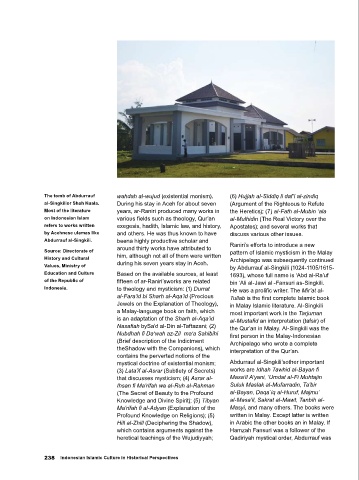Page 248 - INDONESIAN ISLAMIC CULTURE IN HISTORICAL PERSPECTIVES
P. 248
The tomb of Abdurrauf wahdah al-wujud (existential monism). (6) Hujjah al-Siddiq li daf’i al-zindiq a follower of the Syattariyah Sufi order. The same statement is also valid for Pen and ink used to write
al-Singkilior Shah Kuala. During his stay in Aceh for about seven (Argument of the Righteous to Refute As an expert in Sufism, Abdurrauf also Shamsuddin as-Sumatrani’s Mir’at al- manuscripts in the past.
Most of the literature years, ar-Raniri produced many works in the Heretics); (7) al-Fath al-Mubin ‘ala wrote mystical poems, but they are not Mu’min1601 M) in which he wrote “... Source: Directorate of
on Indonesian Islam various fields such as theology, Qur’an al-Mulhidin (The Real Victory over the very well known. Among his poems is the because they do not know Arabic and History and Cultural
refers to works written exegesis, hadith, Islamic law, and history, Apostates); and several works that Syair Ma‘rifa (Gnostic Poetry). His works Persian but only the Pasai language....” Values, Ministry of
32
by Acehnese ulamas like and others. He was thus known to have discuss various other issues. are largely classified as belonging to the Therefore, like Hamzah Fansuri, he wrote Education and Culture
Abdurrauf al-Singkili. beena highly productive scholar and book literature discussed here. in Malay in an attempt to write a book of the Republic of
around thirty works have attributed to Raniri’s efforts to introduce a new in a language that his readers in Aceh
Source: Directorate of pattern of Islamic mysticism in the Malay Indonesia.
History and Cultural him, although not all of them were written Archipelago was subsequently continued Linguistic Aspects of Book and in the archipelago in general could
Values, Ministry of during his seven years stay in Aceh. by Abdurrauf al-Singkili (1024-1105/1615- Literature understand.
Education and Culture Based on the available sources, at least 1693), whose full name is ‘Abd al-Ra’uf In terms of language, the book literature The Malay language Hamzah Fansuri
of the Republic of fifteen of ar-Raniri’sworks are related bin ‘Ali al-Jawi al -Fansuri as-Singkili. used is rated as pure Malay that it does
Indonesia. to theology and mysticism: (1) Durrat He was a prolific writer. The Mir’at al- composed by the scholars discussed not excessively use Arabic. Arabic
al-Fara’id bi Sharh al-Aqa’id (Precious Tullab is the first complete Islamic book above and of a high intellectual is used more for religious terms that
level. Attempts not to use Arabic are
Jewels on the Explanation of Theology), in Malay Islamic literature. Al-Singkili are difficult to translate into Malay. In
a Malay-language book on faith, which most important work is the Tarjuman vocabulary seem to have been strong, addition, another important aspect of
is an adaptation of the Sharh al-Aqa’id al-Mustafid an interpretation (tafsir) of although Arabic influences remained, Hamzah Fansuri’s contribution is his
Nasafiah bySa‘d al-Din al-Taftazani; (2) the Qur’an in Malay. Al-Singkili was the such as the use of: /adalah/, /yakni/, /dan/ initiation in Malay Sufi literature, which
Nubdhah fi Da‘wah az-Zil ma‘a Sahibihi first person in the Malay-Indonesian to support words or phrases. Hamzah indeed has been acknowledged by many
(Brief description of the Indictment Archipelago who wrote a complete Fansuri seemed to stress this aspect. As observers. He is known to have used
theShadow with the Companions), which interpretation of the Qur’an. a Sufi teacher, he wanted his students to very creative language in his poetry. His
contains the perverted notions of the come to exact understanding. Therefore, use of Arabic words is prominent but
mystical doctrine of existential monism; Abdurrauf al-Singkili’sother important he deliberately wrote his works in Malay he integrated them well into his poems’
(3) Lata’if al-Asrar (Subtlety of Secrets) works are Idhah Tawhid al-Bayan fi and not in Arabic or Persian, “so all the structure. Sufi terms as well as other
that discusses mysticism; (4) Asrar al- Masa’il A’yani, ‘Umdat al-Fi Muhtajin people who do not understand Arabic or religious terms do not only play their
Ihsan fi Ma’rifah wa al-Ruh al-Rahman Suluk Maslak al-Mufarradin, Ta’bir Persian can comprehend it”, he wrote roles for the sake of rhyme and rhythm,
(The Secret of Beauty to the Profound al-Bayan, Daqa`iq al-Huruf, Majmu’ in the opening of one of his works, the but also made his poems solid. Arabic
Knowledge and Divine Spirit); (5) Tibyan al-Masa’il, Sakrat al-Mawt, Tanbih al- Sharabu l-’Ashiqin. 31 is also required in order to enable his
Ma’rifah fi al-Adyan (Explanation of the Masyi, and many others. The books were 31. Imran T. Abdullah. “Bahasa Melayu: Lingua readers to understand Sufism. 33
Profound Knowledge on Religions); (5) written in Malay. Except latter is written Franca Islam”, in Taufik Abdullah dan A.B. Lapian
Hill al-Zhill (Deciphering the Shadow), in Arabic the other books an in Malay. If (eds.), Indonesia dalam Arus Sejarah, ….., p. 32. Imran T. Abdullah. “Bahasa Melayu: Lingua
Franca Islam”, in Taufik Abdullah dan A.B. Lapian
which contains arguments against the Hamzah Fansuri was a follower of the 244. See also, Muhammad Naquib Al-Attas, The (ed.), Indonesia dalam Arus Sejarah, ….., p. 244.
Mysticism of Hamzah al-Fansuri, (Kuala Lumpur:
heretical teachings of the Wujudiyyah; Qadiriyah mystical order, Abdurrauf was Universty of Malaya Press, 1970), p. 297. 33. Imran T. Abdullah. “Bahasa Melayu: Lingua
238 Indonesian Islamic Culture in Historical Perspectives Indonesian Islamic Culture in Historical Perspectives 239

